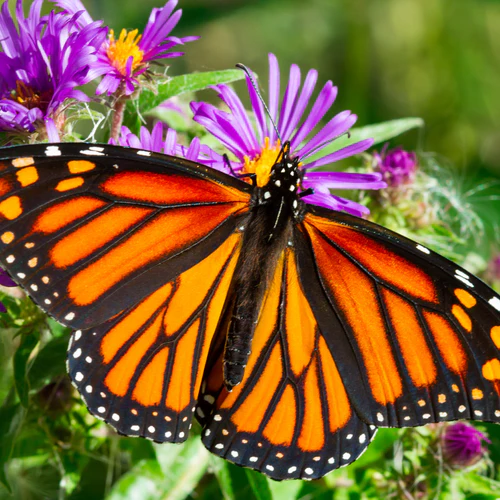
by Wildwood Outdoor Living | Aug 16, 2022 | How To, How To Grow
Whether their delicate presence provides you with symbolic reflection, calm enjoyment or healthy pollinated blooms, butterflies are one of the most beautiful critters to enter our gardens. Lucky for us, these floating beauties can be swayed to visit more often if the conditions are right. In this week’s blog, we’re going to share with you a few tips and tricks to getting more butterflies in your garden.
About Butterflies

[Canadian Tiger Swallowtail]
With over 300 species of butterflies in Canada, the majority of butterflies can be found fluttering between British Columbia and Quebec. As the most recognized butterfly, the Monarch Butterfly can be found on almost every continent around the world.
Unable to withstand Canada’s harsh winters, the Monarch butterfly flies over 4,000 kilometres to Mexico each year, where it spends six months soaking up the sun in the Oyamel Fir Forest of Central Mexico. As Spring starts to unfold in Canada, butterflies like the Monarch start to appear in early April.
Note: Though, with 2 to 6 weeks lifespans, not all butterflies make it to migration. Only the last generation of Monarchs in a single year makes it to the migration phase with an average lifespan of 8 to 9 months long.
Butterfly Habitats

[Mourning Cloak]
Grasslands, deserts, forests, alpines and wetlands are all ideal environments for butterflies to thrive. Since butterflies can be found across many ecosystems, it’s essential to know a few ways butterflies choose their potential homes. Try some of the proven tips and tricks below to meet all the requirements needed to keep your butterflies happy and coming back each and every year.
Butterfly Food

[Milbert’s Tortoiseshell]
During the day, butterflies need rich sources of nectar to provide them with the energy they need to survive. The best nectar for them often comes from colourful and fragrant flower blooms. If attracting more butterflies to your garden is on your agenda, you’ll want to take note of these proven butterfly favourites.
Butterfly homes

After a busy day of pollinating and eating nectar from our gardens, butterflies need a safe place to rest at night. To prevent them from being carried away from the wind, they like to nuzzle themselves between blades of grass, rocks, under leaves or tightly between branches on trees. As gardeners, the best thing we can do to provide a safe shelter for butterflies is to introduce a manmade butterfly home! Place your butterfly home near your popular butterfly flowers to make sure it’s visible, and add some sticks and dry leaves to help entice them.
Hydration

[Dakota Skipper]
Since butterflies have straw-like tongues called ‘proboscis,’ they are restricted to a liquid-only diet. Some ways they can stay hydrated is through the nectar they get from flowers and fruit juices. As a fun activity, try setting out a bottle cap filled with honey water or fruit juice for them to drink from or place one near a butterfly to attract it to you. Or, place some fruit in the sun and see how long it takes for them to find it!
Sun Basking

[Clouded Sulphur]
Butterflies can’t fly when they’re cold. To keep them moving, they often stop to bask in the sun. To help your butterflies stay warm, add a few flat rocks in sunny areas to give them a safe place to soak up the sun!
Dislikes
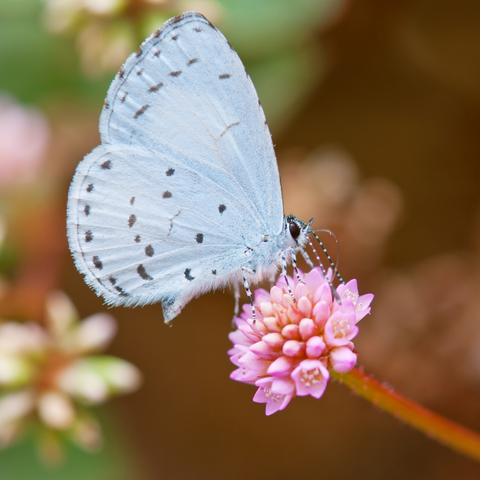
[Summer Azure]
Unfortunately, our poor butterfly friends have many predators, including birds, snakes, rats, wasps, ants, lizards and more. To save them from potential predators, try to be mindful when placing your resources. For example, don’t place your bird feeder and butterfly home in the same place.
Have a suggestion or question?
Let us know at info@wildwoodoutdoorliving.com.
Sign up
here for more blogs dedicated to better gardening!
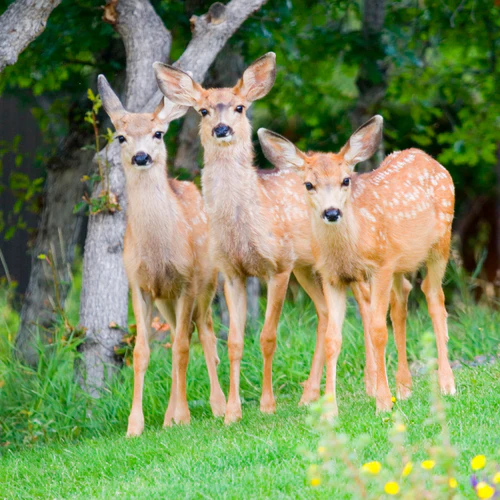
by Wildwood Outdoor Living | Jun 20, 2022 | How To Grow
Have you ever felt the heartbreak of sowing your seeds indoors, transplanting them outdoors, and finally, when they’re just about ready to harvest, they’ve already been harvested! By you know who!? Those cute little deer that have been trotting around the neighbourhood! Who can blame them? Your hard work showed and was genuinely inviting. Don’t worry. We’re here to help your hard work in the garden stand proud. In this article, we’ll help you deter deer from your plants in a few easy steps.
Deer Favourites

The first thing to understand is what attracted the deer to your garden in the first place? It wasn’t the cucumbers, was it? No, they’re too prickly! They were more likely attracted to one of the following plants. It’s essential to take note of all the plants you have that we know deer love so we can do everything possible to protect them.
| Flowering: |
Edible: |
Trees & Foliage: |
| Knock Out Roses |
Beets |
Apple Trees |
| Daylily |
Cabbage |
Arborvitae |
| Pansies |
Apples |
Cherry Trees |
| Azaleas |
Beans |
Hostas |
| Chicory |
Broccoli |
Yew |
| Impatiens |
Leafy Greens |
Chervil |
| Red Clover |
Sweet Corn |
Fennel |
| Cosmos |
Sweet Potatoes |
Fir |
| Sunflowers |
Plums |
Orchard Grass |
| Gerbera |
Strawberries |
Chestnut Trees |
Deer Deterrents
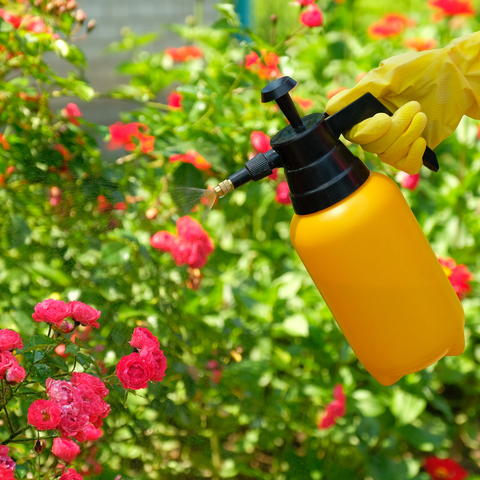
Now that we know what brought the deer to your garden, it’s time to do everything we can to protect the plants we love! Here are a few ways to disguise the deer favourites in your garden, keeping the deer busy elsewhere.
Natural Remedies
If chemicals aren’t an option for you and your garden, a few natural ways have been said to work for deterring deer. Give one of the following natural remedies a shot if you’re looking for a natural-only DIY approach to saving your plants from snacking deer.
- Chilli powder – Sprinkle chilli powder on your plants to not only disguise their scent but disguise their taste as well!
- Irish Spring Soap – If you don’t mind, the esthetic, hanging bars of Irish Spring have been proven to work at disguising deer favourites with their pungent aroma.
- Fabric Softener Sheets – Like soap, they hide the smell of some deer favourites in your yard.
- Hair/Fur – Scattered or tied in mesh bags. It is said that the scent of a predator will keep deer at a safe distance!
- Companion Planting – When planting, research what plants grow best together! Some great companion plants are used to disguise one another from predators like deer, beetles and more.
Deer Repellent
Not all deer repellents are chemical based. Deer Repellent has come a long way to ensure that the safety of ourselves, the deer and our plants are the top priority. If shopping for deer repellent, we recommend using Bobbex Deer Repellent. Bobbex offers an all-natural approach that is environmentally safe. It can be used on most sensitive plantings, trees, shrubs, seedlings and more. This repellent won’t wash off for weeks during the growing season and can last even longer during dormancy.

Deer Dislikes!

Our favourite way to ensure that the deer won’t be coming over for breakfast, lunch or dinner, is to grow plants they don’t like! Surprisingly enough, deer can be picky eaters and if they don’t smell anything good growing at your place, they’ll move right along! Knowing this, we’ve been growing deer-resistant plants for years and we’re here to share a few of our favourites with you to ensure all your hard work goes noticed and not nibbled!
Deer Resistant Bulbs
Deer Resistant Annuals
Deer Resistant Perennials
| Botanical Name |
Common Name |
| Acanthus mollis |
Bear’s Breeches |
| Achillea |
Yarrow |
| Aconitum |
Monkshood |
| Agapanthus |
African Lily |
| Agastache |
Anise Hyssop |
| Ajuga |
|
| Alchemilla |
Lady’s Mantle |
| Anaphalis |
Pearly Everlasting |
| Anemone x hybrida |
Windflower |
| Aquilegia |
Columbine |
| Arabis |
Rock Cress |
| Armeria |
Thrift |
| Artemesia Lactiflora |
Wormwood |
| Asarum caudatum |
Wild Ginger |
| Aster |
|
| Astilbe |
|
| Aubrieta |
|
| Aurinia saxatilis |
Alyssum Saxatile |
| Ballota |
Cuban Oregano |
| Belamcanda chinensis |
Leopard Lily |
| Brunnera macrophylla |
Brunnera |
| Campanula |
Bellfower |
| Centaurea macrocephala |
Globe Cornflower, Basket Flower |
| Cerastium tomentosum |
Snow-in-Summer |
| Cheiranthus |
Wallflower |
| Chrysanthemum |
Hardy Chrysanthemum |
| Convallaria majalis |
Lily-of-the-Valley |
| Crocosmia |
|
| Cyclamen |
|
| Dahlia |
|
| Delphinium |
Larkspur |
| Dicentra |
Bleeding Heart |
| Dierama |
Angel’s Fishing Rod |
| Digitalis |
Foxglove |
| Dracocephalum |
Dragon’s Head |
| Echinacea |
Coneflower |
| Echinops |
Globe Thistle |
| Epimedium |
Barrenwort |
| Eriophyllum lanatum Native |
Woolly Sunflower |
| Eryngium amethystinum |
Sea Holly |
| Erysimum |
Wallflower |
| Eschscholzia |
California Poppy |
| Euphorbia |
Wood Spurge |
| Galium odoratum |
Sweet Woodruff |
| Gaillardia |
Blanket Flower |
| Gentiana |
Gentian |
| Geranium x cantabrigiense |
Cranesbill |
| Geranium macrorrhizum |
Big Root Geranium |
| Geum |
|
| Gunnera manicata |
Giant Rhubarb, Chilian Rhurbarb |
| Gypsophilia paniculata |
Baby’s Breath |
| Helleborus |
Hellebore |
| Hesperis matronalis |
Dame’s Rocket |
| lberis |
Candytuft |
| Iris, esp. bearded types |
Bearded Iris |
| Iris pseudacorus |
Yellow Flag Iris |
| Kniphofia |
Red-hot Poker, Torch
Lily |
| Lamium |
False Salvia,
Deadnettle |
| Lavendula |
Lavender |
| Leucanthemum superbum |
Shasta Daisy |
| Liatris spicata |
Blazing Star, Gay Feather |
| Linaria |
Toadflax |
| Liriope |
Lilyturf |
| Lithodora diffusa |
|
| Lobelia cardinalis |
Cardinal Flower |
| Lupinus |
Lupine |
| Lychnis |
Campions |
| Monarda |
Bergamots |
| Myosotis |
Forget-me-not |
| Nepeta |
Catmint, Catnip |
| Nicotiana |
Flowering Tobacco |
| Oenothera |
Evening Primrose |
| Origanum |
Oregano, Marjoram, Sweet Marjoram |
| Oxalis |
Sorrel |
| Pachysandra |
Japanese Spurge |
| Phlomis |
Jerusalem Sage |
| Paeonia |
Peony |
| Papaver |
Poppy |
| Penstemon |
|
| Perovskia |
Russian Sage |
| Phlox subulata |
Creeping Phlox, Moss Phlox |
| Polemonium |
Jacob’s Ladder |
| Polygonatum |
Solomon’s Seal |
| Pulmonaria |
Lungwort |
| Rheum acuminatum |
Ornamental Rhubarb |
| Romneya coulteri |
California Tree Poppy |
| Rudbeckia fulgida |
Black-eyed Susan |
| Ruta graveolens |
Jackman’s Rue |
| Salvia |
Sage |
| Scabiosa |
|
| Sempervivum |
Hen and Chicks |
| Sisyrinchium |
Blue-eyed Grass |
| Solidago |
Goldenrod |
| Stachys byzantina |
Lamb’s Ears |
| Stylophorum diphyllum |
Celandine Poppy |
| Thalictrun |
Meadow Rue |
| Tiarella |
Foam Flower |
| Tibouchina |
Princess Flower |
| Tradescantias |
Spiderwort |
| Verba scum |
Mullein |
| Veronica |
Speedwell |
| Vinca major |
Periwinkle |
| Viola ordorata |
Sweet Violet |
| Zantedeschia aethiopica |
Calla Lily |
| Zauchchneria |
California Fuchia |
For our full list of deer-resistant plants, click here! Need more inspiration for growing deer-resistant plants? Check out the latest episode of Get Up and Grow, What You Need To Know About Deer Resistant Plants below!
Have a suggestion or question?
Let us know at info@wildwoodoutdoorliving.com.
Sign up here for more blogs dedicated to better gardening!
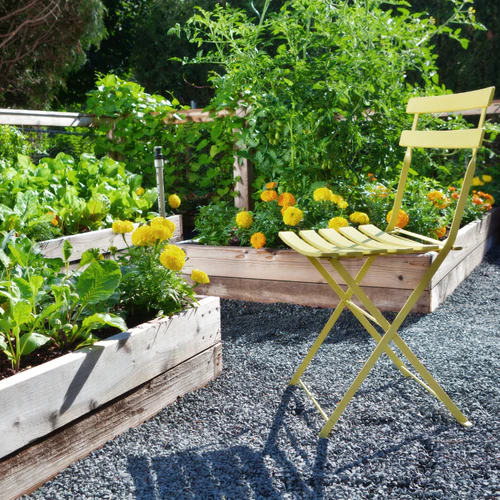
by Wildwood Outdoor Living | Jun 10, 2022 | How To Grow
Whether you live in an apartment building or a house, there are several reasons why raised garden beds are a fantastic option for gardeners. With Spring still in full bloom, it’s a great time to get started on a raised garden bed of your own. In this article, we’re here to share how a raised garden bed could be a game changer for your home garden!
10 Reasons to Use a Raised Garden Bed
- Keep your garden safe from kids & pets playing.
- Prevent burrowing pests from entering by using a base.
- Provide plants with oxygen and good draining.
- A great way to moderate soil needs and types of soil.
- Easy access for those with disabilities, aches and pains – less bending.
- Longer planting season with warmer soil temperatures.
- Neat and tidy gardening, with easy structure support for trellises, netting and strings.
- Helps concentrate all your hard-earned compost to where you need it!
- Allows for gardening in small spaces without yards.
- Easy planning! Raised garden beds are a great way to map out the exact area you have to work with.
Types of Raised Garden Beds

Raised Ground Beds: Using an in-ground garden bed is a great way to prevent weeds from creeping into your garden while also getting all the nutrients mother nature has to offer. In-ground planters built directly into the soil will also allow deeper rooting for plants that need it. Have underground pests? Be sure to apply netting to the bottom of the planter to keep them out. To raise your in-ground garden bed, look for beds that offer extensions like the Veggie Garden Planter above by CR Plastics, with unlimited expansion capabilities for ease.

Containerized Raised Beds – Raised containers come in various sizes and shapes to accommodate many unique growing conditions and spaces. Frequently used on balconies and apartments, they create small garden spaces where gardens aren’t often found. With limited space, herb gardeners are commonly cultivated in raised containers and provide endless supplies of fresh basil, parsley, mint, cilantro and more!

Supported Raised Garden Beds – Do you have an uneven ground for planting? Support your raised garden bed with a built-in bottom and/or by adding legs to support your bed, also known as a raised garden table. This will give you the even lift you need to create an equal distribution for your plants to absorb water and allow you to work in the garden with mobile ease. When choosing your supported raised garden bed, it’s essential to keep in mind the height at which you feel most comfortable working at. If you prefer a chair, opt for a raised bed with legs. If you want to kneel at a comfortable height, take measurements for how tall that would be while in a comfortable kneeling position.
Plant Based Beds

To determine the best raised garden bed for your home, start by knowing what it is you would like to plant. Each plant requires a unique combination of sunlight, water, soil drainage and depth for its roots. For example, if you have decided that you would like to grow tomatoes, you will need a bed with the following requirements.
Example:
| SUN |
Full-sun, preferably in a south-facing location. |
| WATER |
Keep evenly moist; tomatoes don’t like too much water. |
| SOIL |
Well-draining, slightly acidic, rich in nutrients. |
| DEPTH |
12″ or deeper for best root development. |
Once you have carefully mapped out all the requirements to choose your perfect garden bed for your favourite plants, incorporate more plants! The best way to add more plants would be to research similar growing condition plants or companion plants. For tomatoes, we recommend planting herbs; Basil or Parsley, Flowers; Marigolds or Nasturtiums, Vegetables; Asparagus or Garlic.
Tip: Keep in mind how much water your plants may require and how often. Is your raised garden bed in a convenient location to access the water they need?
Tools & Supplies

Now that you’ve chosen your plants and raised garden bed, you’re almost ready! If your plants don’t get nutrients directly from the earth, you will need to prepare nutrient-rich soil for them to grow strong and healthy. We recommend mixing an adequate amount of Sea Soil and/or compost with your soil, plus adequate plant food and to finishing with mulch for good water retention.
To determine the proper nutrients for your plants, you will need to research their individual nutrient needs when grown in a container. Using tomatoes as an example, try Nurseryland Tomato Food 5-10-5.
Have a suggestion or question?
Let us know at info@wildwoodoutdoorliving.com.
Sign up here for more blogs dedicated to better gardening!
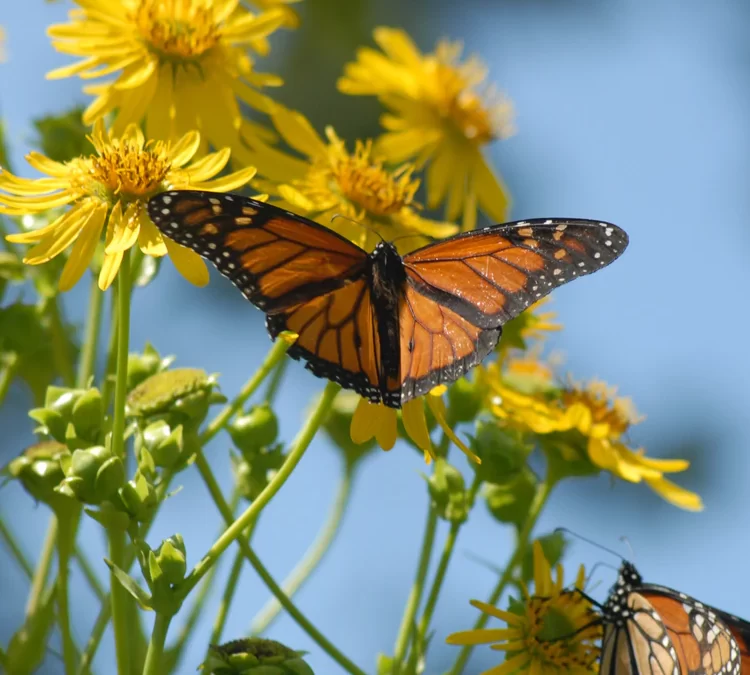
by Wildwood Outdoor Living | May 12, 2022 | How To Grow
By introducing more pollinators to your garden, you can expect higher yields, bigger blooms and more plants! These busy-bee workers aren’t just bees. Pollinators come in a wide variety of insects and mammals. Some fantastic pollinators you can find in Canada are bats, birds, moths, butterflies, flies, wasps, beetles and more. To get you started on attracting more pollinators to your home garden, we’ve created a list of tips to help make these critters feel right at home at your home!
1.) Just Add Water

Like us, our pollinator friends need water to survive! To help keep their wings clean and their thirst quenched, maintain a constant supply of fresh water out for them to rely on. A safe way to do so is by keeping a shallow water dish out with sticks and rocks for perching.
Pro-tip: Try using a refillable dog bowl for a constant fresh water supply.
2.) Less Chemicals, More Nature

While it may seem like an excellent way to get rid of pesky insects, chemical-based products aren’t pollinator friendly. Don’t worry! Chemicals aren’t necessary to get rid of garden pests. In fact, many pollinators like birds, praying mantis, wasps and bats prey on these insects! Making your garden more protein rich for them.
Pro-tip: When in doubt, look for certified organic products!
3.) Single or Double?

The bigger the bloom, the better? Not when it comes to helping our pollinator friends out. With bigger flowers comes more petals to navigate through to get to what really matters -the pollen! To make your garden more appealing for pollinators, introduce single petal blooms for quick and easy pollen access!
4.) Favourite Colours

When we humans look at a garden, we see every colour of the rainbow! Interestingly enough, our bee friends don’t. They see the world through ultraviolet rays, making them unable to see reds! Plant yellows, blues, and purples for high visibility to attract more bees.
Pro-tip: To attract butterflies, plant whites, pinks, purples, reds, yellows and oranges. For hummingbirds, plant plenty of reds!
5.) Group setting

Don’t be shy! Plant more of them when you’ve decided on your favourite pollinator-friendly plants. Planting groups of the same plants together will lure in pollinators like an all-you-can-eat buffet!
Pro-tip: Try naturalizing with plants like Crocus and Snowdrops for mass landscaping.
6.) Hang-out Spots

Like your favourite lazy boy recliner, each pollinator has a favourite hang-out spot. Hummingbirds prefer to hide from the sunshine in shady areas under trees and near bushes. While butterflies and bees prefer energizing in the sunshine. To keep your pollinator guests happy, try placings rocks in the sun for bees and butterflies to catch some rays. While keeping some hummingbird favourites out of the sun so that they can keep their cool.
Pro-tip: For night protection, use a butterfly habit box for butterflies and a mason bee home for mason bees to keep protected from harsh weather.
7.) Bloom time!

The best way to attract pollinators and keep them coming back for more is to have more! Once your blooms are gone, your pollinators will be too. To ensure they stick around, be sure to offer continuous blooms by planning your blooms times. Here is a cheat sheet to keep on hand when you’re planning!
| Early Spring Blooms |
Allium, Chionodoxa, Galanthus, Crocus, Hyacinth, Muscari, Narcissus |
| Sprint to Early Summer Blooms |
Geranium, Iris, Peony, Foxglove, Columbine, Poppy, Bleeding Heart |
| Early to Mid-Summer Blooms |
Common Yarrow, Hosta, Lupine, Larkspur, Coreopsis, Asclepias, Delphinium |
| Mid-summer to Fall Blooms |
Gaillardia, Daisy, Anemone, Lavender, Phlox, Malva, Aster, Monarda, Lobelia |
Have a suggestion or question?
Let us know at info@wildwoodoutdoorliving.com.
Sign up here for more blogs dedicated to better gardening!
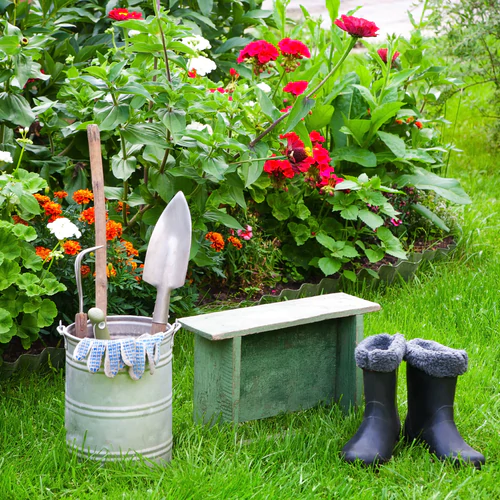
by Wildwood Outdoor Living | May 6, 2022 | How To Grow
You know what they say, April showers bring May flowers! We hope the saying goes for those with snow showers too! Though it might not seem like the weather is warming up, all we can do is chip away at what we can so that we can soak up as much sun as possible when the time comes—looking to get more out of your May garden? We thought so! We’ve created a helpful list of May garden to-do’s to keep you busy.
Lawn & Pond

 |
Start feeding fish as the temperature rises above 5-8 degrees and only feed them what they can eat in 5 minutes. |
 |
May is an ideal month to sow new lawns. |
 |
Use seed and sod starters to get your lawn off right. |
 |
Start fertilizing waterlilies and lotus. |
Clean up & Compost

 |
Lightly shear spring-flowering heather when finished blooming. |
 |
Watch for weeding as temperatures increase weeds will spread quickly. |
 |
Turn over compost or use it if it’s ready. Start over! |
 |
Mulch! Use plenty of mulch to retain moisture all summer long and prevent weeds. Tip: keep grass clippings, bark, pine needles, straw & more for mulching! |
Plants

 |
Lightly shear spring-flowering heather when finished blooming. |
 |
Begin taking routine pest watch strolls; problems treated early are easier to control. |
 |
Deadhead roses and lilies as they fade and fertilize with Uka Blend. |
 |
After flowering, deadhead spring flowering bulbs like tulips, daffodils, and hyacinths to preserve their energy for next year. Watch for fall bulbs pre-orders opening soon for 2022! |
 |
Deadhead pansies and primrose after flowering. |
 |
Plant summer flowering bulbs such as dahlia, begonias, calla lilies, canna lilies, gladiolus and lilies in frost-free areas like containers, beds and borders. |
 |
Harvest cool-season vegetables; kale, cabbage, parsnip, and spinach. |
 |
Plant warm-season vegetables/fruit; onions, cucumbers, tomatoes, cucumber, raspberries, strawberries, blueberries, currants & more! |
 |
Cultivate your vegetable garden regularly to keep the soil loose and allow oxygen to penetrate around the roots. |
 |
Make sure the weather has warmed up and stays warm before planting celosia, impatients, zinnias, fuchsias & or heliotrope. |
 |
A good fertilizing program will go a long way to avoiding black spots and powdery mildew on roses. |
Miscellaneous & More!

 |
Hanging baskets are ready! Choose your favourite blooms and be sure to pick up fertilizer to feed them every 10 days for a summer filled with blooms! |
 |
Watch for weeding as temperatures increase weeds will spread quickly. |
 |
Turn over compost or use it if it’s ready. Start over! |
 |
Mulch! Use plenty of mulch to retain moisture all summer long and prevent weeds. Tip: keep grass clippings, bark, pine needles, straw & more for mulching! |
Looking for more to do? Check out this episode of Get Up and Grow with our president, Gord Nickel to learn How To Remove and Prevent Moss From Your Lawn below!
Have a suggestion or question?
Let us know at info@wildwoodoutdoorliving.com.
Sign up here for more blogs dedicated to better gardening!
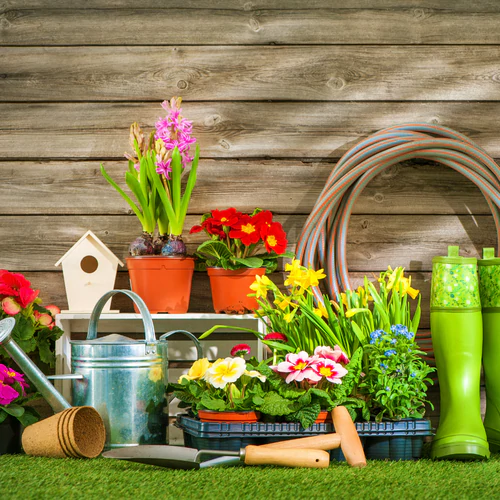
by Wildwood Outdoor Living | May 4, 2022 | How To Grow
Looking for a unique gift idea that has meaning on Mother’s Day? Birth Month Gardens are the newest trend for 2022! Whether you’re helping Mom in the garden or gifting her seasonal blooms that deliver fond memories, the Mom in your life will be sure to know you care with a gift that shows meaning. Whether your birth month flowers are in season or not, birth month gardens are a gift that keeps giving through out the year!
How To: Birth Month Flower Garden
To gift your Mom with a birth month garden, choose either seeds, starters, bulbs or fresh-cut flowers that match you and your siblings or family and friend’s birth months. Below are the flowers that represent each month for you to present to a Mother this year with meaning. Taking a pen and paper, write down your own unique combination of birth flowers to create your own unique birth month flower garden.
|
|
January
|
 |
Carnation: A symbol of strength, love, devotion and protection. The carnation is one of the world’s most popular flowers. Each colour carnation has its own symbolic representation with the pink carnation being the official flower of Mother’s Day! |
 |
Snowdrops: As the first sign of spring, the snowdrop represents new beginnings and consolation. The snowdrop is gifted to those with good intentions and a pure heart. |
|
|
February
|
 |
Violet: Everlasting love, faithfulness and spiritual wisdom. Celebrated in many religions, the violet is often a gift with many spiritual meanings. |
 |
Iris: A symbol of admiration, faith, trust and valour. With over 280 species of Iris, these classic beauties have been adored in folklore tales for centuries. |
|
March
|
 |
Daffodil: Representing spring for its rebirth and new beginnings. With over 13,000 different varieties of daffodils, the daffodil is a present gifted to those to refresh their day! |
 |
Jonquil: Tied to Greek mythology, the Jonquil flower is often mistaken for a daffodil. When gifted to someone it is a symbol of forgiveness with hopes of returned affection. |
|
April
|
 |
Daisy: Gifted to those who have become new mothers. The daisy is a symbol of purity with old Celtic tales of rebirth. |
 |
Sweet Peas: Well wishes, blissful pleasure, friendship and goodbyes are the symbol of Sweet Peas. They are known for their beautifully sweet fragrance, similar to grapes. |
|
May
|
 |
Hawthorne: For centuries brides have used Hawthorne to place in their hair for ceremonies like weddings. They represent hope, faith and happy endings. |
 |
Lily of the Valley With many symbolic meanings, the Lily of The Valley symbolizes Happiness above all. It is said to bring joy to those gifted in bunches on May 1st. |
|
June
|
 |
Rose: Each rose with its own meaning, the red rose symbolizes romance and beauty. Received by those who wish to celebrate love and passion. |
 |
Honeysuckle: As a symbol of pure happiness, the Honeysuckle also signifies the loss of tenderness in love. Though its name has been given to represent the nectar extracted from it’s fragrant blooms. |
|
July
|
 |
Water Lily: Representing wellness and peace, the white Water Lily specifically symbolizes spirituality. Mentioned across many religions for centuries. |
 |
Larkspur: Celebrates positivity and open-hearted attachment to someone. Larkspur comes in shades of pink, white, yellow and red, each with its very own meaning when gifted. |
|
August
|
 |
Poppy: All colours of poppies display their own meaning. A unique orange Poppy symbolizes health and regeneration. The red Poppy is symbolized remembrance and death. |
 |
Gladiolus: The symbol of infatuation. Gladiolus are found in many colours and shapes with over 200 variations. When gifted they are a present of strong character and faithfulness. |
|
September
|
 |
Morning Glory: With every colour of Morning Glory, bring new meaning. For purple morning glory, the symbol of trust and respect is given to its recipient. |
 |
Aster: Placed on the altars in Greek Mythology. The Aster was named by the Greeks after the stars. A long-standing symbol for wisdom, faith and love. |
|
October
|
 |
Marigold: Also known as the Herb of The Sun. Marigold symbolize the power of the sun with strength and the light which is present within someone. |
 |
Cosmos: With their organized petals, the cosmos represent all that is orderly and living in harmony. Assigned “Cosmos” by the ancient Greeks. |
|
November
|
 |
Chrysanthemum: With thousands of varieties, the white Chrysanthemum is a symbol of longevity in love. Chrysanthemums have also been traditionally used in teas as medicine. |
 |
Peony: Given as a gift of well wishes and goodwill. The peony is a true symbol of beauty and romance. With its large unfolding petals in a variety of shapes and colours, the Peony is said to bring a wealthy amount of happiness. |
|
December
|
 |
Narcissus: A symbol of hope and joy since medieval times. The Narcissus got its name from a Greek mythology tale of an attractive man. The Narcissus has 13 subcategories, each with it’s own unique symbolism. |
 |
Holly: With deep religious ties, Holly represents fertility and eternal life. Given as a gift of family happiness. Great for the holiday season! |
The great thing about planting a birth month garden is the variety of blooms and seasonal reminders of the ones you love. To make gifting your birth month garden extra special for mom, try writing or printing out the symbolism and history of each flower above to give with your flower gift. Not sure what months your Mom would like to grow? Give the gift of choice by sending Mom one of our E-Gift Cards. The perfect last-minute gift for any gardener!
Need more inspiration? Maybe you can impress Mom with a year with a few gardening tips and tricks by learning a thing or two from Get Up and Grow with our president, Gord Nickel. Learn How To Prune and Plant Clematis below in just minutes.
Have a suggestion or question?
Let us know at info@wildwoodoutdoorliving.com.
Sign up here for more blogs dedicated to better gardening!


























































